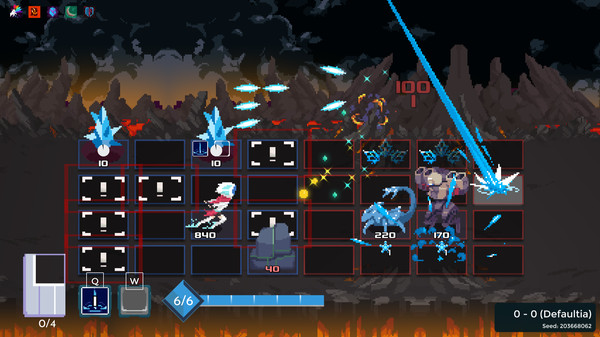

It’s abundantly clear that the developer Thomas poured his heart and soul out. It’s continuous too, but agonizingly weak. On the bright side, there’s a secondary weapon. I felt like the game was actively trying to slow me down in an already fast paced game. Waiting for mana to regenerate to allow you to use an ability is considered a cool down too. Using up all available abilities you have triggers a cool down. With each one you cast, these will funnel into either “A” or “B”. During combat, two will be queued up to either the “A” or “B” button. Spells are represented as cards, and as a collective, they’re known as a “deck”. After each stage, you’ll be able to choose between three new abilities. By default, your character will have a set amount of skills. These grant perks that are permanent throughout a given run.īattling itself is convoluted, so bare with me. This will make you level up, unlocking new abilities, as well as artifacts. Depending on how far you’ve gotten, you receive an amount of “experience”. The RPG elements I mentioned at the beginning kick in here. I feel this cuts an already niche fandom in half, and that’s really not good.įor those familiar with rogue-like, every failure in One Step from Eden will restart your progression. The difficulty spike wasn’t a curve, but instead, a steep incline up. Couple that with my disability, and I struggled to do the required multi-tasking and snappy decision making. The accessibility of the game is quite limited in this regard. Between having to dodge, line up my spells, my positioning, and the abilities that queued up, it was too much. While I do appreciate a good challenge, I felt that One Step from Eden expected far too much.

I’d quickly become overwhelmed and pummelled. Now, in order to target a certain enemy, a black reticle will indicate whom it’ll hit, unless it’s otherwise specified on the ability card. In other words, there’s a – albeit minor – strategic way of going about it. This is because they require a certain amount of mana to be used. As you execute a spell, you’ll notice a mana bar. For those unfamiliar, you’re confined to a 4×4 grid, as are your opponents. In fact, after 20+ hours, I had only unlocked a single costume and some new ability cards.Įssentially, One Step from Eden is a continuous stream of the Battle Network combat system, while also increasing the difficulty. FAINT OF HEART – REJOICE! Game-Play (Mechanics)Īllow me to preface this by outing myself. DUE TO THIS FACT, I CAN ALSO RECOMMEND THIS FOR THE AVERAGE GAMER.
ONE STEP FROM EDEN IGG PATCH
HE’S INFORMED ME THAT ANOTHER PATCH IS COMING TO ADDRESS MOST OF MY COMPLAINTS ABOUT ONE STEP FROM EDEN. I HAVE BEEN IN CONTACT WITH THE DEVELOPER. One Step from Eden isn’t for the faint of heart.
ONE STEP FROM EDEN IGG PC
Based on the praise the PC demo received though, it seemed like a great time was in store. I’ll be honest, I wasn’t sure what to expect when I requested this. It’s a deck-building rogue-like action game with light RPG elements. It’s specifically inspired by the battle system. One Step from Eden is inspired by the Battle Network titles. However, there was always a certain spin-off that escaped me. See, growing up, I was a huge Mega Man fanboy. My obsession for it came about once I heard it’s inspiration. Ultra-high affinity binding to FcRn at both acidic and neutral pH leads to rapid serum clearance.For a year and a half, I’ve followed this game quite closely. Increasing neutral pH FcRn affinity beyond this threshold reduced serum persistence by offsetting the benefits of increased pH 6.0 binding. Variants with pH 7.4 FcRn affinities below this threshold recycle efficiently and can exhibit increased serum persistence. Importantly, the results reveal an underappreciated affinity threshold of neutral pH binding that determines IgG recycling efficiency. Pharmacokinetic studies in human FcRn transgenic mice and cynomolgus monkeys showed that multiple variants with increased FcRn affinities at acidic pH exhibited extended serum half-lives relative to the parental IgG. To better understand pH-dependent binding parameters that govern these outcomes and limit FcRn-mediated half-life extension, we generated a panel of novel Fc variants with high affinity binding at acidic pH that vary in pH 7.4 affinities and assessed pharmacokinetic outcomes. These studies have yielded antibody variants with disparate pharmacokinetic characteristics, ranging from extended in vivo half-life to those exhibiting extremely rapid clearance. The Fc domain of IgG has been the target of multiple mutational studies aimed at altering the pH-dependent IgG/FcRn interaction to modulate IgG pharmacokinetics.


 0 kommentar(er)
0 kommentar(er)
